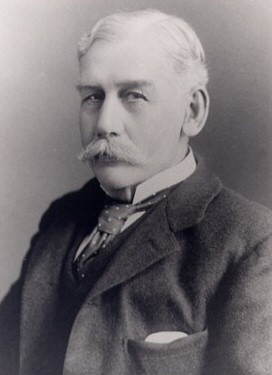Richard Lydekker facts for kids
Quick facts for kids
Richard Lydekker
|
|
|---|---|

Lydekker, ca. 1900
|
|
| Born | 25 July 1849 London, England
|
| Died | 16 April 1915 (aged 65) Harpenden, England
|
| Nationality | English |
| Awards | Lyell Medal (1902) |
| Scientific career | |
| Fields |
|
| Institutions | Trinity College, Cambridge Natural History Museum |
Richard Lydekker (born July 25, 1849 – died April 16, 1915) was an English expert in natural history, a geologist, and a writer. He wrote many books about animals, plants, and the natural world.
Contents
About Richard Lydekker
Richard Lydekker was born in London, England. His father, Gerard Wolfe Lydekker, was a lawyer. Richard went to Trinity College, Cambridge, a famous university, where he studied natural science.
In 1874, he joined the Geological Survey of India. This was a group that studied the Earth's rocks and fossils in India. Richard focused on finding and studying the bones of ancient animals (called vertebrate palaeontology) in northern India, especially in a region called Kashmir. He stayed there until 1881.
His most important work in India was about the ancient animals found in the Siwalik Hills. He also helped organize and list all the fossil mammals, reptiles, and birds at the Natural History Museum in London. He even named some new types of animals, like the golden-bellied mangabey, which is a kind of monkey.
Lydekker's Line and Animal Geography

Richard Lydekker was very important in a science called biogeography. This is the study of where different animals and plants live around the world.
In 1895, he drew a special line on a map of Indonesia. This line is now known as Lydekker's Line. It separates two very different animal regions. To the west of the line is Wallacea, which has animals similar to those in Asia. To the east, you find animals more like those in Australia and New Guinea.
This line follows the edge of the Sahul Shelf, which is a shallow underwater area connecting New Guinea and Australia. Lydekker's Line, along with Wallace's Line and Huxley's Line, helps show how the Earth's geology (like land bridges or deep oceans) affects where animals can live.
The Cuckoo Story
Richard Lydekker once caused a bit of a stir in the newspaper! In 1913, he wrote a letter to The Times newspaper saying he had heard a cuckoo bird. This was unusual because cuckoos usually don't arrive in England until April.
Six days later, he wrote another letter. He admitted that the sound he heard was not a cuckoo at all, but actually a bricklayer's worker making a noise! This funny mistake started a tradition in the newspaper where people would write in about the first cuckoo they heard each year.
Awards and Recognition
In 1902, Richard Lydekker received the Lyell Medal from the Geological Society of London. This award is given to people who have done important work in geology.
Images for kids
See also
 In Spanish: Richard Lydekker para niños
In Spanish: Richard Lydekker para niños


